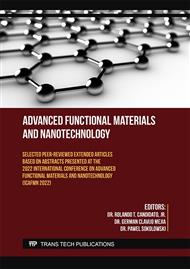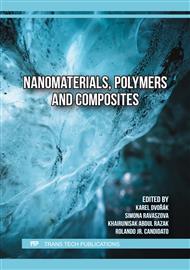[1]
Tchounwou, P. B., Yedjou, C. G., Patlolla, A. K., & Sutton, D. J. (2012). Molecular, clinical and environmental toxicicology Volume 3: Environmental Toxicology. Molecular, Clinical and Environmental Toxicology, 101, 133–164
DOI: 10.1007/978-3-7643-8340-4
Google Scholar
[2]
Nogara, P.A., Farina, M., Aschner, M., & Rocha, J. B. T. (2019). Mercury in Our Food. Chemical Research in Toxicology, 32 (8), 1459–1461. https://doi.org/10.1021/acs.chemrestox. 9b00126
DOI: 10.1021/acs.chemrestox.9b00126
Google Scholar
[3]
Harada, M. (1995). Minamata disease: Methylmercury poisoning in Japan caused by environmental pollution. Critical Reviews in Toxicology, 25(1), 1–24.
DOI: 10.3109/10408449509089885
Google Scholar
[4]
Bernhoft, R. A. (2012). Mercury toxicity and treatment: A review of the literature. Journal of Environmental and Public Health, 2012
DOI: 10.1155/2012/460508
Google Scholar
[5]
Mitra, S., Chakraborty, A. J., Tareq, A. M., Emran, T. Bin, Nainu, F., Khusro, A., … Simal-Gandara, J. (2022). Impact of heavy metals on the environment and human health: Novel therapeutic insights to counter the toxicity. Journal of King Saud University - Science, 34(3), 101865
DOI: 10.1016/j.jksus.2022.101865
Google Scholar
[6]
Lu, Y., Liang, X., Niyungeko, C., Zhou, J., Xu, J., & Tian, G. (2018). A review of the identification and detection of heavy metal ions in the environment by voltammetry. Talanta, 178(July 2017), 324–338
DOI: 10.1016/j.talanta.2017.08.033
Google Scholar
[7]
Du, J., Jiang, L., Shao, Q., Liu, X., Marks, R. S., Ma, J., & Chen, X. (2013). Colorimetric detection of mercury ions based on plasmonic nanoparticles. Small, 9(9–10), 1467–1481
DOI: 10.1002/smll.201200811
Google Scholar
[8]
Budlayan, M. L., Dalagan, J., Lagare-Oracion, J. P., Patricio, J., Arco, S., Latayada, F., … Capangpangan, R. (2022). Detecting mercury ions in water using a low-cost colorimetric sensor derived from immobilized silver nanoparticles on a paper substrate. Environmental Nanotechnology, Monitoring and Management, 18(August), 100736
DOI: 10.1016/j.enmm.2022.100736
Google Scholar
[9]
Liu, D., Qu, W., Chen, W., Zhang, W., Wang, Z., & Jiang, X. (2010). Highly sensitive, colorimetric detection of mercury(II) in aqueous media by quaternary ammonium group-capped gold nanoparticles at room temperature. Analytical Chemistry, 82(23), 9606–9610
DOI: 10.1021/ac1021503
Google Scholar
[10]
Zou, Y., Pang, J., Zhang, F., & Chai, F. (2021). Silver Nanoparticles for Colorimetric Detection and Discrimination of Mercury Ions in Lake Water. ChemistrySelect, 6(24), 6077–6082
DOI: 10.1002/slct.202101389
Google Scholar
[11]
Sangaonkar, G. M., Desai, M. P., Dongale, T. D., & Pawar, K. D. (2020). Selective interaction between phytomediated anionic silver nanoparticles and mercury leading to amalgam formation enables highly sensitive, colorimetric and memristor-based detection of mercury. Scientific Reports, 10(1), 1–12
DOI: 10.1038/s41598-020-58844-4
Google Scholar
[12]
Klingel, T., Kremer, J. I., Gottstein, V., & Rezende, T. R. De. (2020). A Review of Coffee By-Products Including Leaf ,. Foods, 9, 1–20.
Google Scholar
[13]
Hemlata, Meena, P. R., Singh, A. P., & Tejavath, K. K. (2020). Biosynthesis of Silver Nanoparticles Using Cucumis prophetarum Aqueous Leaf Extract and Their Antibacterial and Antiproliferative Activity against Cancer Cell Lines. ACS Omega, 5(10), 5520–5528
DOI: 10.1021/acsomega.0c00155
Google Scholar
[14]
Rajkumar, G., & Sundar, R. (2022). Sonochemical-assisted eco-friendly synthesis of silver nanoparticles (AgNPs) using avocado seed extract: Naked-eye selective colorimetric recognition of Hg2+ ions in aqueous medium. Journal of Molecular Liquids, 368, 120638
DOI: 10.1016/j.molliq.2022.120638
Google Scholar
[15]
Kalam, A., Al-Sehemi, A. G., Alrumman, S., Du, G., Pannipara, M., Assiri, M., … Moustafa, M.F. (2017). Colorimetric Sensing of Toxic Metal and Antibacterial Studies by Using Bioextract Synthesized Silver Nanoparticles. Journal of Fluorescence, 27(6), 2045–2050
DOI: 10.1007/s10895-017-2143-x
Google Scholar
[16]
Some, S., Bulut, O., Biswas, K., Kumar, A., Roy, A., Sen, I. K., … Ocsoy, I. (2019). Effect of feed supplementation with biosynthesized silver nanoparticles using leaf extract of Morus indica L. V1 on Bombyx mori L. (Lepidoptera: Bombycidae). Scientific Reports, 9(1), 1–13
DOI: 10.1038/s41598-019-50906-6
Google Scholar
[17]
Rezazadeh, N. H., Buazar, F., & Matroodi, S. (2020). Synergistic effects of combinatorial chitosan and polyphenol biomolecules on enhanced antibacterial activity of biofunctionalized silver nanoparticles. Scientific Reports, 10(1), 1–13
DOI: 10.1038/s41598-020-76726-7
Google Scholar
[18]
Mittal, A.K., Bhaumik, J., Kumar, S., & Banerjee, U. C. (2014). Biosynthesis of silver nanoparticles: Elucidation of prospective mechanism and therapeutic potential. Journal of Colloid and Interface Science, 415, 39–47
DOI: 10.1016/j.jcis.2013.10.018
Google Scholar
[19]
Parmar, A., Kaur, G., Kapil, S., Sharma, V., Choudhary, M. K., & Sharma, S. (2019). Novel biogenic silver nanoparticles as invigorated catalytic and antibacterial tool: A cleaner approach towards environmental remediation and combating bacterial invasion., Materials Chemistry and Physics, 238(July), 121861
DOI: 10.1016/j.matchemphys.2019.121861
Google Scholar
[20]
Wan Mat Khalir, W. K. A., Shameli, K., Jazayeri, S. D., Othman, N. A., Che Jusoh, N. W., & Hassan, N. M. (2020). Biosynthesized Silver Nanoparticles by Aqueous Stem Extract of Entada spiralis and Screening of Their Biomedical Activity. Frontiers in Chemistry, 8
DOI: 10.3389/fchem.2020.00620
Google Scholar
[21]
Azimpanah, R., Solati, Z., & Hashemi, M. (2018). Green synthesis of silver nanoparticles and their applications as colorimetric probe for determination of Fe3+ and Hg2+ ions. IET Nanobiotechnology, 12(5), 673–677
DOI: 10.1049/IET-NBT.2017.0236
Google Scholar
[22]
Sarkar, P. K., Halder, A., Polley, N., & Pal, S. K. (2017). Development of Highly Selective and Efficient Prototype Sensor for Potential Application in Environmental Mercury Pollution Monitoring. Water, Air, and Soil Pollution, 228(8), 1–11
DOI: 10.1007/s11270-017-3479-1
Google Scholar
[23]
Demirezen Yılmaz, D., Aksu Demirezen, D., & Mıhçıokur, H. (2021). Colorimetric detection of mercury ion using chlorophyll functionalized green silver nanoparticles in aqueous medium. Surfaces and Interfaces, 22(September 2020), 100840
DOI: 10.1016/j.surfin.2020.100840
Google Scholar
[24]
Narayanan, K. B., & Han, S. S. (2017). Highly selective and quantitative colorimetric detection of mercury(II) ions by carrageenan-functionalized Ag/AgCl nanoparticles. Carbohydrate Polymers, 160, 90–96
DOI: 10.1016/j.carbpol.2016.12.055
Google Scholar
[25]
Lobregas, M. O. S., Bantang, J. P. O., & Camacho, D. H. (2019). Carrageenan-stabilized silver nanoparticle gel probe kit for colorimetric sensing of mercury (II) using digital image analysis. Sensing and Bio-Sensing Research, 26(September)
DOI: 10.1016/j.sbsr.2019.100303
Google Scholar
[26]
Ghosh, S., Maji, S., & Mondal, A. (2018). Study of selective sensing of Hg2+ ions by green synthesized silver nanoparticles suppressing the effect of Fe3+ ions. Colloids and Surfaces A: Physicochemical and Engineering Aspects, 555(April), 324–331
DOI: 10.1016/j.colsurfa.2018.07.012
Google Scholar
[27]
Jeevika, A., & Shankaran, D. R. (2022). Shape dependent interaction of silver nanostructures with mercury for its sensing applications. Optik, 270(January), 170041
DOI: 10.1016/j.ijleo.2022.170041
Google Scholar



